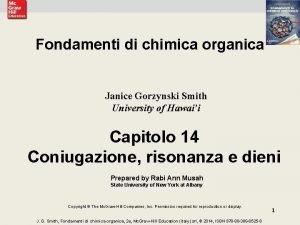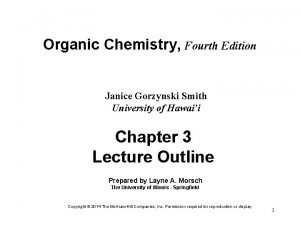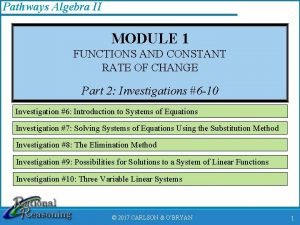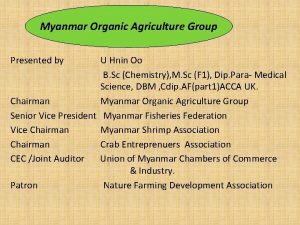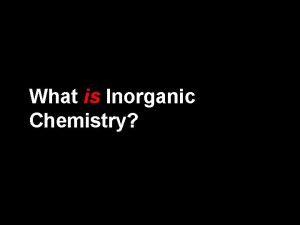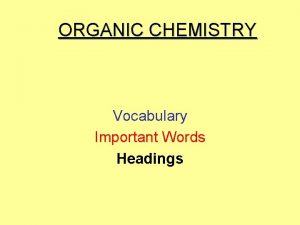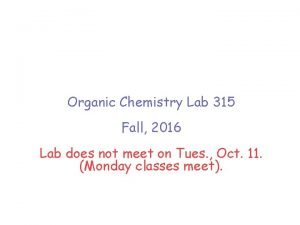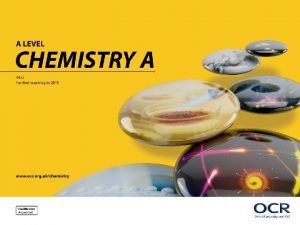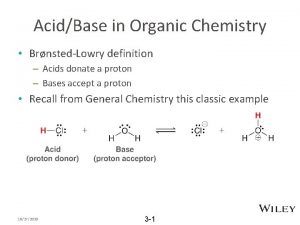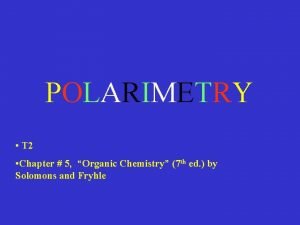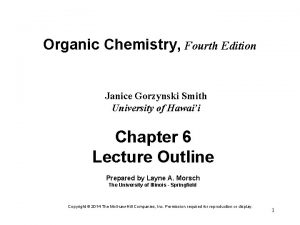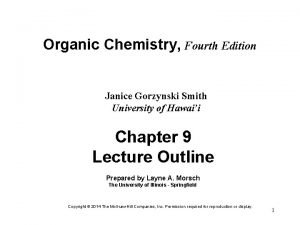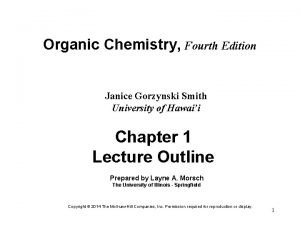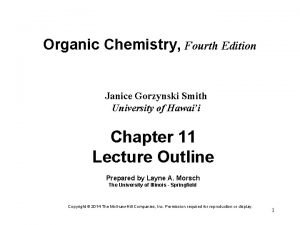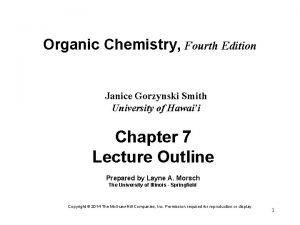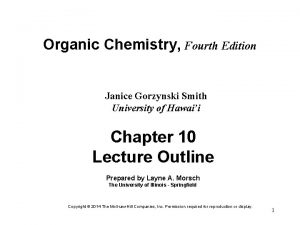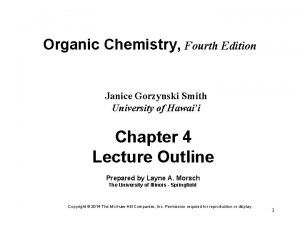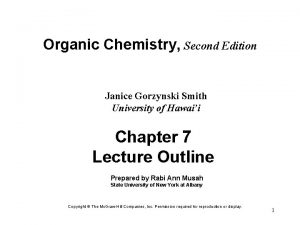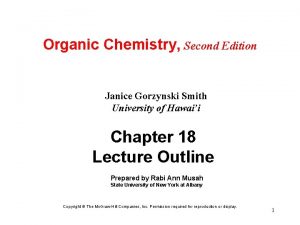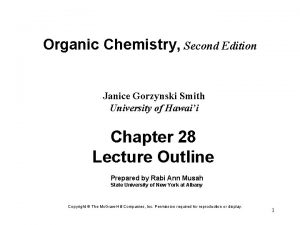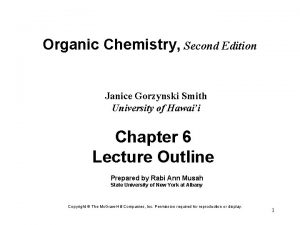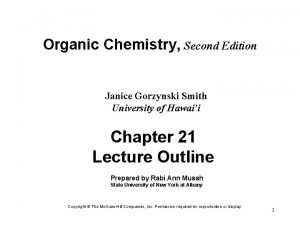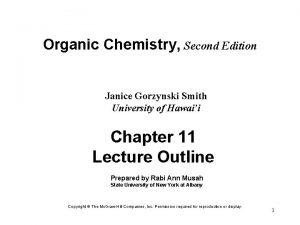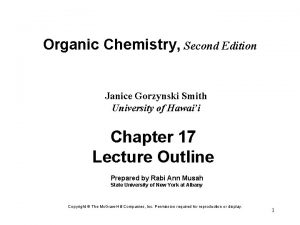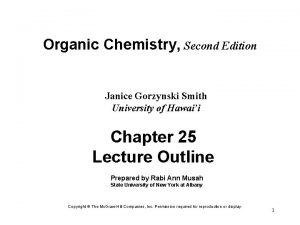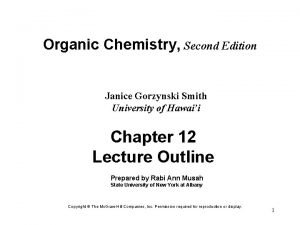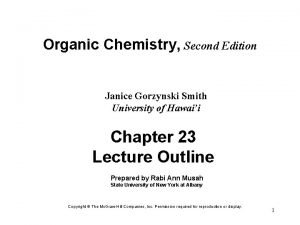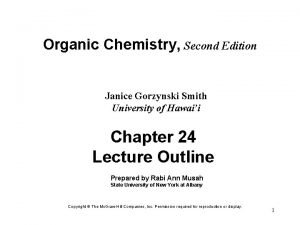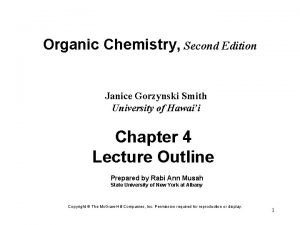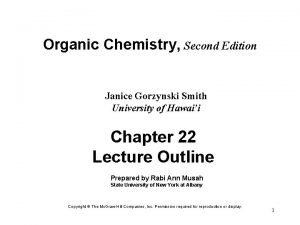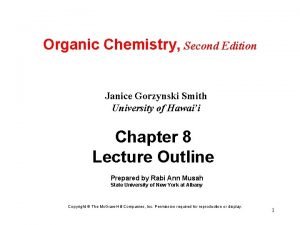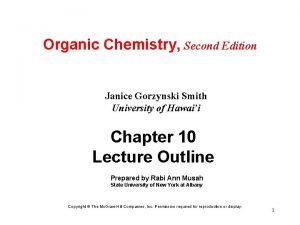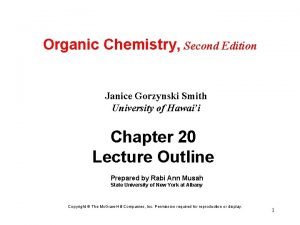Organic Chemistry Fourth Edition Janice Gorzynski Smith University




































![Formation of Bromine from NBS • The HBr formed in Step [2] reacts with Formation of Bromine from NBS • The HBr formed in Step [2] reacts with](https://slidetodoc.com/presentation_image_h/0b263bcf9578f129b0eccebaedc8abd6/image-37.jpg)

















- Slides: 54

Organic Chemistry, Fourth Edition Janice Gorzynski Smith University of Hawai’i Chapter 15 Lecture Outline Prepared by Layne A. Morsch The University of Illinois - Springfield Copyright © 2014 The Mc. Graw-Hill Companies, Inc. Permission required for reproduction or display. 1

Radicals • A small but significant group of reactions involve radical intermediates. • A radical is a reactive intermediate with a single unpaired electron, formed by homolysis of a covalent bond. • A radical contains an atom that does not have an octet of electrons. • Half-headed arrows are used to show the movement of electrons in radical processes. 2

Structure of Radicals • Carbon radicals are classified as 1°, 2°, or 3°. • A carbon radical is sp 2 hybridized and trigonal planar, like carbocations. • The unhybridized p orbital contains the unpaired electron and extends above and below the trigonal planar carbon. 3

Bond Dissociation Energies • Bond dissociation energies for the cleavage of C—H bonds are used to measure stability. • They are determined by calculating the energy needed to break the bond into two radicals. • Cleaving a stronger bond requires more energy. • In the example below, the 2 o radical is more stable than the 1 o radical because less energy is required to produce it. 4

Stability of Radicals Figure 15. 1 The relative stability of 1° and 2° carbon radicals 5

General Features of Radical Reactions • Radicals are formed from covalent bonds by adding energy in the form of heat ( ) or light (h ). • Some radical reactions are carried out in the presence of a radical initiator. • Radical initiators, such as peroxides of general structure, RO –OR, contain an especially weak bond that serves as a source of radicals. • Heating a peroxide readily causes homolysis of the weak O–O bond, forming two RO • radicals. • Radicals undergo two main types of reactions—they react with bonds, and they add to bonds. 6

Reaction of a Radical X • with a C–H Bond • A radical X • , once formed, rapidly reacts with whatever is available, usually a stable or bond. • A radical X • abstracts a hydrogen atom from a C–H bond to form H–X and a carbon radical. 7

Reaction of a Radical X • with a C=C Bond • A radical X • can also add to the bond of a carbon–carbon double bond. • In either type of radical reaction (with a or bond) a new radical is created. 8

Inhibition of Radicals by Molecular Oxygen • Occasionally, two radicals react to form a sigma bond. • An example is the reaction of a radical with oxygen (a diradical in its ground state electronic configuration). • Reaction with oxygen causes the reaction to slow down or stop, as X–O–O • radicals are not as reactive as halogen radicals. • Compounds that prevent radical reactions from occurring are called radical inhibitors or radical scavengers. 9

Radical Halogenation of Alkanes • In the presence of heat or light, alkanes react with halogens to form alkyl halides by a radical substitution reaction. • Halogenation of alkanes is only useful with Cl 2 or Br 2. • Reaction with F 2 is too violent, and reaction with I 2 is too slow to be useful. 10

Radical Halogenation of Alkanes • With an alkane that has more than one type of hydrogen atom, a mixture of alkyl halides may result. • When a single hydrogen atom on a carbon has been replaced by a halogen atom, monohalogenation has taken place. 11

Radical Halogenation of Alkanes • When excess halogen is used, it is possible to replace more than one hydrogen atom on a single carbon with halogen atoms. • Monohalogenation can be achieved experimentally by adding halogen X 2 to an excess of alkane. Figure 15. 2 Complete halogenation of CH 4 using excess Cl 2 12

Halogenation of Alkanes—Mechanism • Three facts about halogenation suggest that the mechanism involves radical, not ionic, intermediates: 13

Common Steps of Radical Reactions • Radical halogenation has three distinct steps: • This type of mechanism that involves two or more repeating steps is called a chain mechanism. • The most important steps of any chain mechanism including radical halogenation are the propagation steps which lead to product formation. 14

15

Energy Changes in Radical Propagation Figure 15. 3 16

Energy Diagram for Radical Propagation Figure 15. 4 17

Product Mixture in Radical Chlorination • Chlorination of CH 3 CH 2 CH 3 CH 2 Cl and (CH 3)2 CHCl. affords a 1: 1 mixture of • CH 3 CH 2 CH 3 has six 1° hydrogens and only two 2° hydrogens, so the expected product ratio of CH 3 CH 2 Cl to (CH 3)2 CHCl (assuming all hydrogens are equally reactive) is 3: 1. 18

Radical Halogenation of Alkanes • Since the observed ratio between CH 3 CH 2 Cl and (CH 3)2 CHCl is 1: 1, the 2° C–H bonds must be more reactive than the 1° C–H bonds. • Thus, when alkanes react with Cl 2, a mixture of products results, with more product formed by cleavage of the weaker C –H bond than you would expect on statistical grounds. 19

Chlorination vs Bromination • Although alkanes undergo radical substitutions with both Cl 2 and Br 2, chlorination and bromination exhibit two important differences. 1. Chlorination is faster than bromination. 2. Chlorination is unselective, yielding a mixture of products, but bromination is more selective, often yielding one major product. 20

Energy of Halogenation • The differences in chlorination and bromination can be explained by considering the relative energetics of their key propagation steps. • Calculating Ho using bond dissociation energies reveals that abstraction of a 1° or 2° hydrogen by Br • is endothermic. • However, it takes less energy to form the more stable 2° radical, and this difference is more important in endothermic steps. 21

Energy Diagram for Endothermic Reaction—Bromination Figure 15. 5 • Because the rate-determining step is endothermic, the transition state resembles the products. • The more stable radical is formed faster, and often a single 22 radical halogenation product predominates.

Energy of Radical Formation • Calculating H° using bond dissociation energies for chlorination reveals that abstraction of a 1° or 2° hydrogen by Cl • is exothermic. • Since chlorination has an exothermic rate-determining step, the transition state to form both radicals resembles the same starting material, CH 3 CH 2 CH 3. • Thus, the relative stability of the two radicals is much less important, and both radicals are formed. 23

Figure 15. 6 Energy Diagram for Exothermic Reaction—Chlorination • Because the rate-determining step in chlorination is exothermic, the transition state resembles the starting material, both radicals are formed, and a mixture of products results. 24

Predicting Stereochemistry of Reactions 25

Stereochemistry from Achiral Starting Material • Halogenation of an achiral starting material such as CH 3 CH 2 CH 3 forms two constitutional isomers by replacement of either a 1° or 2° hydrogen. • 1 -Chlorobutane has no stereogenic centers and is thus achiral. • 2 -Chlorobutane has a new stereogenic center, and so an equal amount of two enantiomers must form—a racemic mixture. 26

Racemates from Achiral Starting Material • A racemic mixture results because the first propagation step generates a planar sp 2 hybridized radical. • Cl 2 then reacts with it from either side to form an equal amount of two enantiomers. 27

Stereochemistry from Chiral Starting Material Chlorination at the Chiral Center • Chlorination at C 2 occurs at the stereogenic center. • Radical halogenation reactions at a stereogenic center occur with racemization. 28

Stereochemistry from Chiral Starting Material Chlorination Away from the Chiral Center • Chlorination at C 3 does not occur at the stereogenic center, but forms a new stereogenic center. • Since no bond is broken to the stereogenic center at C 2, its configuration is retained during the reaction. • The trigonal planar sp 2 hybridized radical is attacked from either side by Cl 2, forming a new stereogenic center. • A pair of diastereomers is formed. 29

The Ozone Layer and CFCs • Ozone is vital to life, and acts as a shield, protecting the earth’s surface from harmful UV radiation. • Current research suggests that chlorofluorocarbons (CFCs), used extensively as refrigerants and propellants, are responsible for destroying ozone in the upper atmosphere. 30

CFCs and the Destruction of the Ozone Layer Figure 15. 7 31

Alternatives to CFCs • The overall result is that O 3 is consumed as a reactant and O 2 is formed. • In this way, a small amount of CFC can destroy a large amount of O 3. • New alternatives to CFCs are hydrochlorofluorocarbons (HCFCs) and hydrofluorocarbons (HFCs) such as CH 2 FCF 3. • These compounds are decomposed by HO • before they reach the stratosphere and therefore, they do not take part in the radical reactions resulting in O 3 destruction. 32

Radical Halogenation at an Allylic Carbon • An allylic carbon is a carbon adjacent to a double bond. • Homolysis of the allylic C–H bond in propene generates an allylic radical which has an unpaired electron on the carbon adjacent to the double bond. • The bond dissociation energy for this process is even less than that for a 3° C–H bond (91 kcal/mol). • This means that an allyl radical is more stable than a 3° radical. 33

Stability of Allyl Radicals • The allyl radical is more stable than other radicals because the bond and the unpaired electron are delocalized. • The “true” structure of the allyl radical is a hybrid of the two resonance structures. • Declocalizing electron density lowers the energy of the hybrid, thus stabilizing the allyl radical. 34

NBS—a Radical Bromination Reagent • Because allylic C–H bonds are weaker than other sp 3 hybridized C–H bonds, the allylic carbon can be selectively halogenated using NBS in the presence of light or peroxides. • NBS contains a weak N–Br bond that is homolytically cleaved with light to generate a bromine radical, initiating an allylic halogenation reaction. • Propagation then consists of the usual two steps of radical halogenation. 35

36
![Formation of Bromine from NBS The HBr formed in Step 2 reacts with Formation of Bromine from NBS • The HBr formed in Step [2] reacts with](https://slidetodoc.com/presentation_image_h/0b263bcf9578f129b0eccebaedc8abd6/image-37.jpg)
Formation of Bromine from NBS • The HBr formed in Step [2] reacts with NBS to form a low concentration of Br 2. • This is then used for halogenation in Step [3] of the mechanism. 37

Radical vs Ionic Bromination • An alkene with allylic C–H bonds undergoes two different reactions depending on the reaction conditions. • Addition and Substitution 38

Why NBS Favors Substitution Over Addition A low concentration of Br 2 (from NBS) favors allylic substitution over ionic addition to form the dibromide. • The Br 2 produced from NBS, present in very low concentrations, must first react with the double bond to form the bridged bromonium ion. • The bridged bromonium ion must then react with more bromine (in the form of Br−) in a second step to form the dibromide. • If concentrations of both intermediates—the bromonium ion and Br− are low (as is the case here), the overall rate of addition is very slow, and the products of the very fast and facile radical chain reaction predominate. 39

Regiochemistry of Allylic Halogenation • Halogenation at an allylic carbon often results in a mixture of products. • A mixture results because the reaction proceeds by way of a resonance-stabilized radical. 40

Oxidation of Unsaturated Lipids • Oils are susceptible to allylic free radical oxidation. Figure 15. 8 41

Antioxidants • An antioxidant is a compound that stops an oxidation reaction from occurring. • Naturally occurring antioxidants such as vitamin E prevent radical reactions that can cause cell damage. • Synthetic antioxidants such as BHT—butylated hydroxy toluene—are added to packaged and prepared foods to prevent oxidation and spoilage. • Vitamin E and BHT are radical inhibitors, which terminate radical chain mechanisms by reacting with the radical. 42

Mechanism of Antioxidant Behavior • To trap free radicals, both vitamin E and BHT use a hydroxy group bonded to a benzene ring—a general structure called a phenol. • Radicals (R • ) abstract a hydrogen atom from the OH group of an antioxidant, forming a new resonance-stabilized radical. • This new radical does not participate in chain propagation, but rather terminates the chain and halts the oxidation process. • Because oxidative damage to lipids in cells is thought to play a role in the aging process, many antiaging formulations contain antioxidants. 43

General Radical Additions to Alkenes • Electron rich alkenes react with electron deficient radicals. • Radicals react with alkenes via radical chain mechanisms consisting of: • Initiation, propagation and termination steps • HBr adds to alkenes to form alkyl bromides in the presence of heat, light, or peroxides. 44

Radical Additions to Alkenes • The regioselectivity of the addition to unsymmetrical alkenes is different from that for addition of HBr in the absence of heat, light, or peroxides. • The addition of HBr to alkenes in the presence of heat, light, or peroxides proceeds via a radical mechanism. 45

46

Regiochemistry of Radical Addition to Alkenes • In the first propagation step, the addition of Br • to the double bond, there are two possible paths: 1. Path [A] forms the less stable 1° radical. 2. Path [B] forms the more stable 2° radical. • The more stable 2° radical forms faster, so Path [B] is preferred. 47

Radical vs Ionic Addition of HBr • Depending on the reaction conditions, a different species initially reacts with the p bond accounting for the difference in regioselectivity. • Radical addition involves initial attack by a bromine radical. • Ionic addition involves initial attack by a proton. 48

Energy Changes of Radical HBr Addition • HBr adds to alkenes under radical conditions, but HCl and HI do not, due to differences in bond dissociation energies. • Both propagation steps for HBr addition are exothermic, so propagation is exothermic (energetically favorable) overall. • For addition of HCl or HI, one of the chain propagating steps is quite endothermic, and thus too difficult to be part of a repeating chain mechanism. Figure 15. 9 49

Polymers and Polymerization • Polymers are large molecules made up of repeating units of smaller molecules called monomers. • They include biologically important compounds such as proteins and carbohydrates, as well as synthetic plastics such as polyethylene, polyvinyl chloride (PVC) and polystyrene. • Polymerization is the process of joining together of monomers to make polymers. • For example, joining ethylene monomers together forms the polymer polyethylene, a plastic used in milk containers and plastic bags. 50

Polymers from Ethylene Derivatives • Many ethylene derivatives having the general structure CH 2=CHZ are also used as monomers for polymerization. • The identity of Z affects the physical properties of the resulting polymer. • Polymerization of CH 2=CHZ usually affords polymers with Z groups on every other carbon atom in the chain. 51

52

53

Radical Polymerization • In radical polymerization, the more substituted radical always adds to the less substituted end of the monomer, a process called head-to-tail polymerization. 54
 Janice gorzynski smith
Janice gorzynski smith Transition state energy diagram
Transition state energy diagram Pericyclic
Pericyclic Is alkane an organic compound
Is alkane an organic compound Organic chemistry david klein 3rd edition
Organic chemistry david klein 3rd edition Organic chemistry david klein 3rd edition
Organic chemistry david klein 3rd edition Organic chemistry third edition david klein
Organic chemistry third edition david klein Organic chemistry (3rd) edition chapter 2 problem 17s
Organic chemistry (3rd) edition chapter 2 problem 17s Organic chemistry
Organic chemistry Organic chemistry second edition david klein
Organic chemistry second edition david klein Janice smith
Janice smith Ib chemistry functional groups
Ib chemistry functional groups Inorganic chemistry vs organic chemistry
Inorganic chemistry vs organic chemistry Project 2 fourth edition
Project 2 fourth edition Pathways algebra 2 answer key
Pathways algebra 2 answer key Ethics in information technology fourth edition
Ethics in information technology fourth edition Ethics in information technology 6th edition answers
Ethics in information technology 6th edition answers Project 4 fourth edition
Project 4 fourth edition Discrete math susanna epp
Discrete math susanna epp Expert systems: principles and programming, fourth edition
Expert systems: principles and programming, fourth edition Founder of organic chemistry
Founder of organic chemistry Soap organic chemistry
Soap organic chemistry Ester organic chemistry
Ester organic chemistry But-1-ene to but-2-ene
But-1-ene to but-2-ene Ee organic chemistry
Ee organic chemistry Ario organic chemistry
Ario organic chemistry What is the leveling effect organic chemistry
What is the leveling effect organic chemistry Priority order of functional group ncert
Priority order of functional group ncert Organic chemistry lab report format
Organic chemistry lab report format Alkane organic chemistry
Alkane organic chemistry Organic chemistry grade 10
Organic chemistry grade 10 Cyclo organic chemistry
Cyclo organic chemistry Organic vs inorganic compounds
Organic vs inorganic compounds Kiliani fischer synthesis
Kiliani fischer synthesis Meth eth prop but
Meth eth prop but Chemistry cracking
Chemistry cracking But prop
But prop Organic chemistry myanmar
Organic chemistry myanmar Electrophilic addition hbr
Electrophilic addition hbr M+2 mass spec
M+2 mass spec Hono organic chemistry
Hono organic chemistry Propyl bromide
Propyl bromide Topic 11 organic chemistry
Topic 11 organic chemistry Chapter 22 review organic chemistry section 1 answers
Chapter 22 review organic chemistry section 1 answers Organic chemistry reaction pathways
Organic chemistry reaction pathways Organic chemistry nomenclature
Organic chemistry nomenclature What is organic chemistry like
What is organic chemistry like Is ch4o organic or inorganic
Is ch4o organic or inorganic Organic chemistry vocabulary
Organic chemistry vocabulary Separation scheme of caffeine from vivarin tablets
Separation scheme of caffeine from vivarin tablets A level chemistry ocr organic synthesis
A level chemistry ocr organic synthesis Define compound lipids
Define compound lipids Ario acidity
Ario acidity How to calculate percentage yield in organic chemistry
How to calculate percentage yield in organic chemistry Polarimetry organic chemistry
Polarimetry organic chemistry
